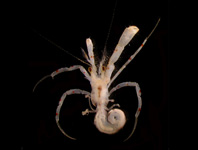Abstract
Harvestmen (Opiliones) are a diverse order of arachnids composed of more than 6,600 described species which together span an almost global distribution. Although these animals may occur in extremely high abundance in both pristine and disturbed habitats, much of harvestman diversity remains undescribed, undocumented, and/or in need of taxonomic attention. In the current study, we focus on the harvestman diversity of the state of Minnesota, USA, where a lack of local expertise and effort has left the species richness of the state largely undocumented. We document two genera and seven species previously unrecorded in the state.—Leiobunum aldrichi, L. calcar, L. flavum, L. politum, L. ventricosum, L. vittatum, and Odiellus pictus.
References
Banks, N. (1894) Washington Phalangida, with description of a new southern Liobunum. The Canadian Entomologist, 26 (6), 160–164.
https://doi.org/10.4039/Ent26160-6Bishop, S.C. (1949) The Phalangida (Opiliones) of New York. Proceedings of the Rochester Academy of Science, 9 (3), 159–235.
Bishop, S.C. & Crosby, C.R. (1924) A fossil species of Caddo (Opiliones) from the Baltic Amber, and its living relatives. New York State Museum Bulletin, 253, 83–87.
Burns, M., Hedin, M. & Shultz, J.W. (2012) Molecular phylogeny of the leiobunine harvestmen of eastern North America (Opiliones: Sclerosomatidae: Leiobuninae). Molecular Phylogenetics and Evolution, 63, 291–298.
https://doi.org/10.1016/j.ympev.2011.12.025Burns, M., Hedin, M. & Shultz, J.W. (2013) Comparative analysis of reproductive structures in harvestmen (Opiliones) reveal multiple transitions from courtship to precopulatory antagonism. PLoS ONE, 8 (6) e66767.
https://doi.org/10.1371/journal.pone.0066767Burns, M. & Shultz, J.W. (2015) Biomechanical diversity of mating structures among harvestmen species is consistent with a spectrum of precopulatory strategies. PLoS ONE, 10 (9), e0137181.
https://doi.org/10.1371/journal.pone.0137181Burns, M. & Shultz, J. W. (2016) Mechanical properties of male genitalia in Leiobunum harvestmen (Arachnida, Opiliones, Sclerosomatidae). Journal of Arachnology, 44 (2), 199–209.
https://doi.org/10.1636/JoA-S-15-010Cokendolpher, J.C. & Lee, V.F. (1993) Catalogue of the Cyphopalpatores and Bibliography of the Harvestmen (Arachnida, Opiliones) of Greenland, Canada, U.S.A., and Mexico. Vintage Press, Lubbock, Texas, II + 82 pp.
Cokendolpher, J.C. & Zeiders, K.R. (2004) Clarence Moores Weeds (1864-1947) and notes on his species of Opiliones (Arachnida). Occasional Papers of the Museum of Texas Tech University, 237, 1–14.
Crosby, D.R. (1911) A new species of Phalangida from Missouri. The Canadian Entomologist, 43 (1), 20–22.
https://doi.org/10.4039/Ent4320-1Davis, N. (1934) A revision of the genus Leiobunum (Opiliones) of the United States. American Midland Naturalist, 15 (6), 662–705.
https://doi.org/10.2307/2419891Edgar, A.L. (1966) Phalangida of the Great Lakes Region. American Midland Naturalist, 75 (2), 346–366.
https://doi.org/10.2307/2423397Giribet, G. & Sharma, P.P. (2015) Evolutionary biology of harvestmen (Arachnida, Opiliones). Annual Reviews of Entomology, 60, 157–175.
https://doi.org/10.1146/annurev-ento-010814-021028Goodnight, C.J. & Goodnight, M.L. (1943) New and little know phalangids from the United States. The American Midland Naturalist, 29 (3), 643–656.
https://doi.org/10.2307/2421154Goodnight, C.J. & Goodnight, M.L. (1945) Phalangida from the United States. Journal of the New York Entomological Society, 53 (3), 239–245.
Hedin, M., Tsurusaki, N., Macías-Ordóñez, R. & Shultz, J.W. (2012) Molecular systematics of sclerosomatid harvestmen (Opiliones, Phalangioidea, Sclerosomatidae): geography is better than taxonomy in predicting phylogeny. Molecular Phylogenetics and Evolution, 62, 224–236.
https://doi.org/10.1016/j.ympev.2011.09.017Ingianni, E.A., McGhee, C.R. & Shultz, J.W. (2011) Taxonomy of the Leiobunum calcar species-group (Opiliones: Sclerocomatidae: Leiobununae). Journal of Arachnology, 39 (3), 454–481.
https://doi.org/10.1636/Ha11-42.1Katayama, R.W. (1969) The Phalangida of North Dakota. Master’s Thesis, North Dakota State University, Fargo, North Dakota, 70 pp.
Levi, L.R. & Levi, H.W. (1952) Preliminary list of harvestmen of Wisconsin with a key to the genera. Transactions of the Wisconsin Academy of Science, Arts, and Letters, 47, 43–52.
Linnæus, C. (1758) Systema naturæ per regna tria naturæ, secundum classes, ordines, genera, species, cum characteribus, differentiis, synonymis, locis. Vol. 1. 10th Edition. Impensis Direct. Laurentii Salvii, Holmiae, 824 pp.
McGhee, C. (1977) The politum group (bulbate species) of Leiobunum (Arachnida: Phalangida: Phalangidae) of North American. Journal of Arachnology, 3, 151–163.
Packard, A.S. (1884) New cave arachnids. American Naturalist, 18 (2), 202–204.
Say, T. (1821) An account of the arachnides of the United States. Journal of the Academy of Natural Sciences Philadelphia, 2 (1), 59–82.
Weed, C.M. (1890a) A new Phalangium. The American Naturalist, 24 (284), 783–783
Weed, C.M. (1890b) The harvest spiders of North America. American Naturalist, 24 (285), 866–867.
https://doi.org/10.1086/275200Weed, C.M. (1893) A synopsis of the harvest-spiders (Phalangiidae) of South Dakota. Transactions of the American Entomology Society, 20 (4), 285–292.
Wood, H.C. (1868) On the Phalangea of the United States of America. Proceedings of the Essex Institute, 6, 10–40.

